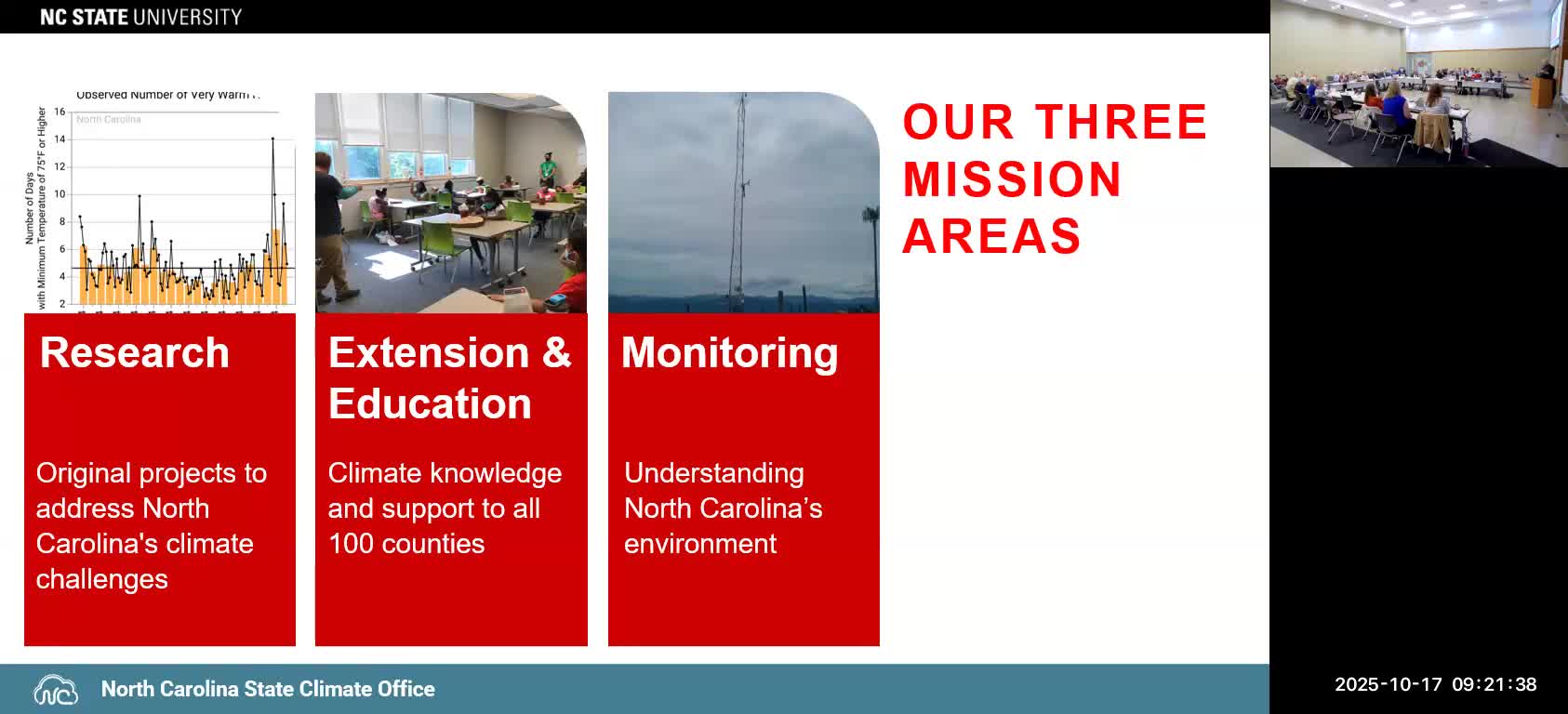State climate office: Chatham County likely to warm in coming decades; planners urged to size infrastructure for hotter nights and heavier downpours
November 11, 2025 | Chatham County, North Carolina
This article was created by AI summarizing key points discussed. AI makes mistakes, so for full details and context, please refer to the video of the full meeting. Please report any errors so we can fix them. Report an error »

Jared Brown, interim director of the North Carolina State Climate Office, told Chatham County officials and advisory committee members at a retreat that the county is already warmer than it was a century ago and should plan for substantially hotter summers and stronger rain extremes. “Since about the preindustrial record, we've warmed about 1.3 degrees Fahrenheit in Chatham County,” Brown said, and multi-model projections show another 2½–3½°F of mean warming in the next 25 years.
Brown said the recent rise in overnight temperatures — ‘‘warm nights’’ — is a significant driver of the local warming signal and has implications for public health and energy demand. “It’s not cooling as much at night because you’re increasing the humidity…so the number of very warm nights has been increasing,” he said. Brown also pointed to increasing intensity of rare rainfall events and said that, while annual totals may not change dramatically, the largest downpours are coming in shorter, more intense bursts.
To help planners translate those projections into design choices, Brown demonstrated monitoring and modeling tools maintained by the state climate office. He described North Carolina EcoNet, an observational network with a station in Siler City, and Cardinal, a data portal that provides historical station records. For future-focused stormwater design, he showed Raindrop — a tool that combines observations and model projections so engineers can see how a 25- or 100-year storm depth may change under different emissions scenarios and time horizons. “Engineers need numbers so they can come in, point and click and get a number,” Brown said.
Brown warned that higher-emissions scenarios increase uncertainty in outcomes but also the chance of larger, damaging changes later in the century: simulations of historic hurricanes run in warmer atmospheres produced larger rainfall totals and faster intensification near landfall. The presenter urged local leaders to use the tools to re-evaluate culverts, bridges and long-lived infrastructure. He also flagged public-health risks tied to extreme heat, noting spikes in heat-related illnesses during recent seasons in the state.
County staff and committee members responded with technical and operational questions, including whether the county could host additional monitoring stations (Brown said the state would support placement and noted 45 EcoNet stations statewide) and how to fold the Raindrop output into DOT and stormwater design workflows. Brown said some DOT contractors are already using the data to stress-test infrastructure designs for a 25- to 75-year planning horizon.
The State Climate Office presentation is expected to feed into the county’s climate-action planning process through tools and data shared with staff and technical committees; no formal policy decisions were taken at the retreat.
Next steps: county staff said they would share Brown’s slides and links to EcoNet and Raindrop so planners, engineers and public-health officials can review model output and incorporate the state’s scenarios into ongoing infrastructure and emergency-planning work.
Brown said the recent rise in overnight temperatures — ‘‘warm nights’’ — is a significant driver of the local warming signal and has implications for public health and energy demand. “It’s not cooling as much at night because you’re increasing the humidity…so the number of very warm nights has been increasing,” he said. Brown also pointed to increasing intensity of rare rainfall events and said that, while annual totals may not change dramatically, the largest downpours are coming in shorter, more intense bursts.
To help planners translate those projections into design choices, Brown demonstrated monitoring and modeling tools maintained by the state climate office. He described North Carolina EcoNet, an observational network with a station in Siler City, and Cardinal, a data portal that provides historical station records. For future-focused stormwater design, he showed Raindrop — a tool that combines observations and model projections so engineers can see how a 25- or 100-year storm depth may change under different emissions scenarios and time horizons. “Engineers need numbers so they can come in, point and click and get a number,” Brown said.
Brown warned that higher-emissions scenarios increase uncertainty in outcomes but also the chance of larger, damaging changes later in the century: simulations of historic hurricanes run in warmer atmospheres produced larger rainfall totals and faster intensification near landfall. The presenter urged local leaders to use the tools to re-evaluate culverts, bridges and long-lived infrastructure. He also flagged public-health risks tied to extreme heat, noting spikes in heat-related illnesses during recent seasons in the state.
County staff and committee members responded with technical and operational questions, including whether the county could host additional monitoring stations (Brown said the state would support placement and noted 45 EcoNet stations statewide) and how to fold the Raindrop output into DOT and stormwater design workflows. Brown said some DOT contractors are already using the data to stress-test infrastructure designs for a 25- to 75-year planning horizon.
The State Climate Office presentation is expected to feed into the county’s climate-action planning process through tools and data shared with staff and technical committees; no formal policy decisions were taken at the retreat.
Next steps: county staff said they would share Brown’s slides and links to EcoNet and Raindrop so planners, engineers and public-health officials can review model output and incorporate the state’s scenarios into ongoing infrastructure and emergency-planning work.
View the Full Meeting & All Its Details
This article offers just a summary. Unlock complete video, transcripts, and insights as a Founder Member.
✓
Watch full, unedited meeting videos
✓
Search every word spoken in unlimited transcripts
✓
AI summaries & real-time alerts (all government levels)
✓
Permanent access to expanding government content
30-day money-back guarantee

